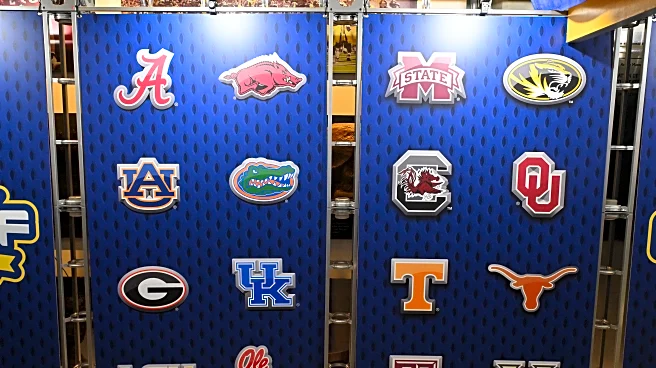What's Happening?
The Southeastern Conference (SEC) has revealed the permanent opponents for Texas A&M University in the upcoming 2026-29 seasons, as the conference transitions to a nine-game schedule. According to a leak by Chris Low from On3, Texas A&M will face Texas, LSU, and Missouri annually. The selection of Texas and LSU as opponents is seen as a natural choice due to the strong rivalries and historical significance between these teams and Texas A&M. However, the inclusion of Missouri as the third opponent has raised some eyebrows, as there is less historical animosity between the two schools. Despite this, the annual match-up could potentially foster a new rivalry. The decision not to include Arkansas, a geographically and historically significant rival, has disappointed some Aggies fans. Nonetheless, the new schedule aims to balance competition by ensuring teams play each other both at home and away over a four-year period.
Why It's Important?
The announcement of Texas A&M's permanent SEC opponents is significant for several reasons. Firstly, it solidifies the competitive landscape for the Aggies, ensuring that they face historically strong teams like Texas and LSU, which could enhance the team's visibility and rivalry intensity. The inclusion of Missouri might not initially seem impactful, but it could lead to the development of new competitive dynamics. The decision reflects broader strategic moves within the SEC to balance team schedules and foster competitive equity. This change could influence recruiting strategies, fan engagement, and media coverage, as teams prepare for consistent high-stakes matchups. The exclusion of Arkansas, despite its historical ties, suggests a shift in focus towards maintaining rivalries that are deemed more commercially and competitively viable.
What's Next?
As the SEC moves towards implementing the nine-game schedule, teams like Texas A&M will begin strategizing for these permanent matchups. Coaches and players will likely focus on building strategies that leverage historical rivalries with Texas and LSU, while also preparing to face Missouri annually. Fans and stakeholders can expect increased anticipation and preparation for these games, potentially leading to heightened ticket sales and media attention. The SEC's decision may also prompt discussions among other teams regarding their permanent opponents, influencing future scheduling and conference dynamics.
Beyond the Headlines
The decision to include Missouri as a permanent opponent for Texas A&M could have deeper implications for the SEC's strategic direction. It suggests a potential shift towards fostering new rivalries and expanding the competitive narrative within the conference. This move might also reflect considerations beyond immediate fan preferences, such as long-term commercial interests and geographic balance. The evolving landscape of college football, with conferences expanding and restructuring, highlights the importance of adaptability and strategic foresight in maintaining competitive balance and fan engagement.











